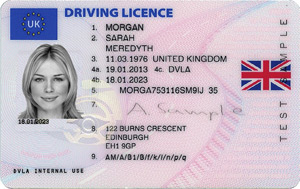DVSA Motorcycle Theory Test Practice 2024
| How many questions: | 50 |
|---|---|
| How many correct answers to pass: | 43 |
| Pass mark: | 86% |

These 50 multiple-choice questions are based on the official motorcycle theory test questions from the Driver and Vehicle Standards Agency (DVSA). Use these questions to practise before you take the actual motorcycle theory test, and you may gain confidence and even a better score. When you’ve passed your motorcycle theory test, you can go on to take your practical test and gain a full motorcycle licence. Good luck!
List of questions (classic view)
- How often should the indicators on your motorcycle flash?
- You should not overtake another vehicle
- You are riding behind a lorry on a wet road. Spray is making it hard for you to see clearly. How should you handle this?
- You are approaching a junction. A cyclist in front of you has extended his or her right arm. What should you do?
- Why should you allow some extra space when overtaking another motorcyclist in windy conditions?
- You are riding at the legal speed limit, but the vehicle behind you is flashing its headlights. What should you do?
- When you are about to change lanes on a busy dual carriageway, what should you always do?
- You notice that the steering on your motorbike feels wobbly. What could be causing it?
- Which road users may take unusual paths at a roundabout?
- Which of these vehicles is most stable in crosswinds?
- What should you do when you are riding towards an unmarked crossroads?
- As a motorcycle rider, what can you do to improve your safety on the road?
- For which of the following should you leave extra room when overtaking it?
- What should you do if your mobile phone rings while you're riding your motorcycle?
- Before riding your motorbike in snowy conditions, what should you do?
- You are forced to brake hard as a driver suddenly pulls out of a side road in front of you. What should you do?
- You are on a three-lane motorway with no traffic ahead of you. Your speed is 70 mph. Which lane should you be travelling in?
- The oil seal on your shock absorber has developed a fault. This may be a major problem. Why?
- You see a series of horizontal yellow lines painted across the road. Their purpose is
- You are at the scene of an accident, and you see that someone's arm is bleeding. Nothing is embedded in the arm, so what should you do to help?
- You have third-party insurance on your motorcycle. What does it cover?
- Another motorcycle is approaching you in broad daylight with its dipped headlight on. What is the most likely reason for this?
- Why may the ability of an elderly person on the road be adversely affected?
- A temporary traffic light is red, but there is no other traffic to be seen. What should you do?
- You are riding in very cold weather. The road around you looks wet, and you can't hear any noise from the road. What should you do?
- There is a crosswind as you ride along a motorway. When should you take extra care?
- You are planning to take a long journey on the motorway. Why is it especially important to check your motorbike before you set out?
- Looking at your tyres, you notice that one of the sidewalls has a tear. What should you do?
- What does the law say about carrying luggage on a motorcycle?
- As you ride in slow-moving traffic, a vehicle is following close behind. What should your course of action be?
- An injured person can go into shock. What is a sign of shock?
- On a long journey, when should you rest?
- You have noticed that other motorcyclists look over their right shoulder before they turn in that direction. Why are they doing this?
- You are riding towards a traffic signal that has been green for a long time. What should you do?
- A sign warns of loose chippings ahead. What should you do?
- What should you always do when you leave your motorbike parked up for any length of time?
- For the first time ever, you are riding your motorcycle with a sidecar attached to it. What should you do?
- What is the average braking distance when riding at 50 mph on a good road surface in good conditions?
- What is the purpose of the two-second rule when you are riding in good, dry conditions?
- You are about to ride someone else’s motorcycle. Before riding it, you must ensure that
- Road signs that give orders typically have a ____________ shape.
- You plan to turn right at the end of a road, but there are parked vehicles blocking your view. What should you do?
- As you approach a crossroads, you see that the traffic lights are not working. What should you do?
- While you are riding, your tyre gets a sudden puncture. What should you do?
- What is the purpose of your motorbike's engine cut-out switch?
- As you approach a roundabout, horses are in the road ahead of you. What should you do?
- A bus is ahead of you at a bus stop and has its right indicator on. What should you do?
- Why must you make full use of the slip road before you join a motorway on your motorcycle?
- Compared with good conditions, freezing conditions can increase your stopping distance by as much as
- Why should you always use your mirrors if you spot a hazard in the road ahead of you?